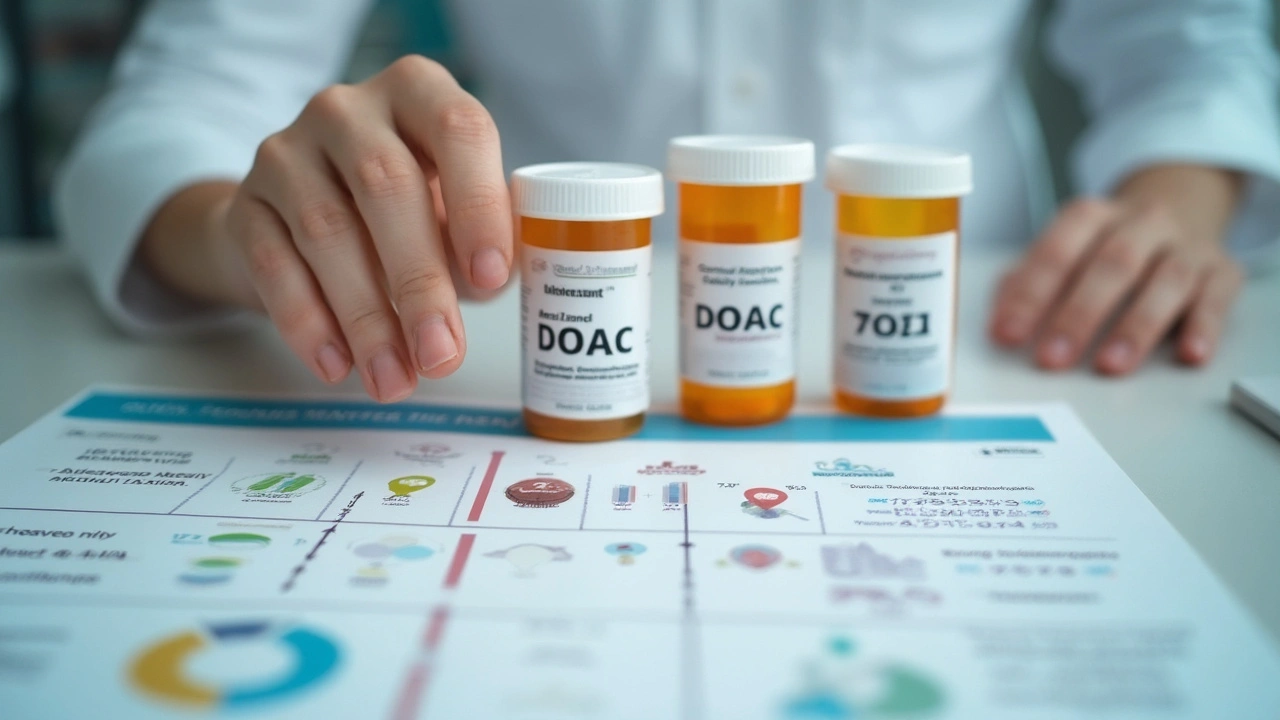
Warfarin's had a good run—over 60 years, if you're counting—but times change. More and more people are asking their doctors about direct oral anticoagulants (DOACs) like apixaban, rivaroxaban, and dabigatran. There's a reason for this shift: convenience and confidence. If you’re tired of getting your blood drawn to check INR, you’re absolutely not alone. DOACs promise reliable anticoagulation without the fussy monitoring, wild dietary restrictions, or constant dose adjustments. They’re at the heart of the movement toward making anticoagulation easier, safer, and in some cases, quite a bit less stressful.
Let’s be real—warfarin isn’t going away entirely, but its reputation as the only strong option is on the way out. Over the past decade, we’ve seen several clinical trials stack up strong evidence for DOACs working just as well as warfarin for conditions like atrial fibrillation (the notorious "A-fib"), venous thromboembolism (think deep vein clots and pulmonary embolisms), and even for preventing clots after joint surgery. Unlike warfarin, which acts by blocking Vitamin K, DOACs target specific clotting factors (either Factor Xa or thrombin) and create a more predictable anticoagulation effect. This means fewer surprises for both patients and their doctors. In fact, by early 2025, nearly 75% of new anticoagulation prescriptions in North America are for DOACs rather than warfarin, according to a new registry summary published in February.
Switching from warfarin to a DOAC comes with a handful of changes—most of them for the better. Gone are the days of memorizing which foods will affect drug levels, and nobody's setting alarms for weekly lab draws anymore. All you need is a pill, some water, and a reminder app if you tend to forget. More patients, especially older adults, appreciate this freedom. The pattern is similar worldwide: Europe, South America, Australia, and large cities in Asia are favoring DOACs for most first-time anticoagulation patients unless there's a serious reason warfarin is still needed (mechanical heart valves being the big exception).
If you’ve been taking warfarin for a while, you might worry: Does new always mean better? The answer is...well, sometimes. Let’s break down how apixaban, rivaroxaban, and dabigatran compare in actual outcomes vs. the old standby.
First up, stroke prevention in atrial fibrillation. In the ARISTOTLE trial, one of the largest studies of its type, apixaban cut the risk of stroke by 21% and even lowered the risk of major bleeding compared to warfarin. If you look at rivaroxaban, it performed just as well as warfarin in stopping strokes—without the runaround of monitoring. Dabigatran? Same story: it delivers either similar or slightly better stroke risk reduction, and at the higher approved dose, actually reduced the risk of hemorrhagic stroke (the kind you really want to avoid).
Bleeding is the big fear with any blood thinner. Warfarin’s bleeding risk is well-documented, and it’s part of the anxiety for both patients and providers. Multiple studies since 2015 (and reinforced by 2023 European Cardiology Congress updates) show that apixaban and dabigatran have a lower risk for serious bleeding, especially the dangerous brain bleeds. Gastrointestinal bleeding risks are a bit higher with some DOACs like dabigatran and rivaroxaban, particularly in adults over 75, but the reduction in brain bleeds more than balances this for most people.
If you’re wondering about actual numbers, here’s a quick snapshot of what researchers found in major head-to-head studies.
| Drug | Stroke Reduction vs. Warfarin | Major Bleeding Risk | Convenience |
|---|---|---|---|
| Apixaban | Better | Lower | High |
| Rivaroxaban | Similar | Similar/Lower | High |
| Dabigatran | Similar or Better | Lower (brain); Higher (gut) | High |
DOACs are not magic bullets, but they are extremely effective for the big indications—prevention of stroke, treatment and prevention of deep vein thrombosis (DVT), and pulmonary embolism (PE). For people who have trouble keeping their INR stable on warfarin—or anyone tired of living by the color-coded pill box—DOACs really do provide a practical edge.
Don’t forget that in rare cases, such as people with mechanical heart valves or severe kidney problems, warfarin is still the only real option. But for most adults—especially those over 60, who make up the largest group needing anticoagulation—the option to use a DOAC opens doors for better quality of life.

This is one of those game-changing differences. With warfarin, regular INR checks are non-negotiable. You can eat a bowl of spinach or take a cold medicine, mess up your levels, and suddenly you’re in the danger zone. Hospitals and clinics still spend hours every day checking INRs and calling with dose adjustments—it adds up to a serious quality-of-life hassle.
Here’s where DOACs make their case. In nearly all cases, routine blood testing just isn’t needed. You start the medication, follow directions, and go about your life. There are still some lab checks involved—notably, kidney function—and doctors will want to see you at least every 6–12 months to make sure nothing’s changed in your health. Apixaban and rivaroxaban, both Factor Xa inhibitors, don’t build up in the body the way warfarin can. Dabigatran (a direct thrombin inhibitor) needs a bit more kidney function, so your care team will watch this a bit closer, especially if your eGFR is under 50.
One very practical tip: set a phone reminder for your next kidney function test. Not because DOACs are dangerous, but because being proactive saves headaches. If you have any conditions that come and go, like bad infections or hospitalizations, flag it for your provider, as these things can affect how your body handles a DOAC. For young and otherwise healthy people, these concerns are minor, but for those over 70 or those with fluctuating kidney status, doctors pay a bit closer attention.
On the topic of emergencies, here’s something you might not know: DOACs now have FDA-approved reversal agents for severe bleeding. Idarucizumab can reverse dabigatran in minutes, and andexanet alfa will knock down the effects of apixaban and rivaroxaban. Warfarin’s reversal involves a more complicated process (vitamin K plus blood products). This makes modern DOAC therapy even more appealing for people who just want peace of mind.
No blood thinner is free of side effects—it comes with the territory. But DOACs generally carry fewer quirky interactions than warfarin. With warfarin, you’re avoiding leafy greens one month and skipping herbal tea the next. One wild interaction (cranberry juice, anyone?) can mess up your levels for days. That unpredictability is a common reason people look into warfarin alternatives in the first place.
DOACs sidestep most food issues. You don’t need to read the salad bar menu like it’s a government regulation. But drug interactions still exist. You’ll want to tell your doctor about every new prescription, over-the-counter pill, or big change in supplements. Certain antifungals, HIV drugs, and anti-seizure medications can push blood levels of DOACs up or down. Don’t be shy about bringing in your medicine list at every visit.
Common side effects? Mostly mild. Some people get stomach upset or mild nausea with dabigatran, which is why you’ll often see it paired with food or a full glass of water. Gastrointestinal bleeding is more likely with rivaroxaban if you’re over 75, so staying hydrated and being mindful of warning signs—think black stools, sudden drops in blood pressure, or unexplained fatigue—is smart. Another rare issue, skin rashes or minor allergic reactions, shows up in less than 2% of new users, and can almost always be managed by switching medications. True life-threatening bleeding is rare, clocking in at less than 2 episodes per 1,000 patient-years for all DOACs, which is an improvement on warfarin’s rate in most real-world studies.
If you’re getting older or have a history of kidney problems, apixaban is often the first pick because it’s less affected by changes in kidney filtering. Dabigatran is great for lower body clot prevention but get your kidney numbers checked before making it the default. For active folks or those who need a simple once-daily schedule, rivaroxaban is appealing, since it cuts down on forgotten doses.
One last word: always, always keep a digital or paper list of your medications on your phone or in your wallet. If you’re ever in an emergency, ER staff need to know exactly what you’re on—not just “a blood thinner.”

If you ask most people on DOACs what life is like now versus warfarin, the first word is “freedom.” Goodbye to clinics for endless blood draws. Hello to stable dosing, no matter what you eat, and fewer medication freak-outs before a barbecue or salad night. It sounds trivial, but that day-to-day liberation is a huge factor, especially for busy folks, frequent travelers, or anyone who just wants a normal life.
There’s some practical stuff you’ll want to keep in mind. DOACs only work as well as your routine—missed doses undo their protection quickly, so getting into a daily flow really matters. Some people use pill organizers and smartphone alarms, while others find that tying their dose to another daily habit (like brushing teeth) does the trick. If you’re planning surgery or a dental procedure, your provider may want you to stop your DOAC a day or two ahead of time. The exact schedule depends on your kidney health and which DOAC you’re on, so don’t guess—always get specific instructions.
There’s also a wave of new, once-weekly DOACs in clinical trials as of spring 2025. Imagine taking your blood thinner once a week instead of daily—that’s the holy grail for folks who have trouble sticking to daily pills. But if your insurance only covers existing DOACs, don’t stress—the approved ones do the trick for almost everyone who needs reliable anticoagulation outside of very niche exceptions.
No matter how great new drugs become, the key to safe use is partnership—between you and your care team. People who ask questions, report new symptoms fast, and double-check their other meds have better outcomes. You don’t need to memorize complex science. Ask your doctors about changes in your energy, appetite, and any new bruises or odd bleeding. It’s not about fear—it’s about being proactive, so tiny problems never snowball into big ones.
At the end of the day, DOACs put more control back in your hands. No one dreams of being on a blood thinner, but if you need one, you can now choose an option that respects your time, your routines, and your safety. Keep your care team in the loop, check in with your own body, and don’t settle for less than a medication plan that works for your actual life.
When you start a DOAC, keep an eye on kidney function at baseline and then every 6–12 months, especially for dabigatran which is cleared renally. If eGFR falls below 30 ml/min, dose adjustments or a switch to a less kidney‑dependent agent like apixaban may be needed. A simple serum creatinine check paired with the patient’s weight can guide safe dosing without the hassle of weekly INR labs. This proactive approach helps maintain efficacy while minimizing bleed risk.
Sounds like a win for patients! 😊
In the UK, NICE now recommends apixaban as first‑line for non‑valvular atrial fibrillation unless contraindicated, reflecting its lower intracranial bleed profile.
The pharmacodynamic stability of factor‑Xa inhibitors translates into a narrower therapeutic index, reducing inter‑patient variability and obviating the need for routine coagulation assays, which is a paradigm shift from vitamin K antagonist management.
While the hype around DOACs is justified, many clinicians overlook the cost barrier and the fact that real‑world adherence can be lower than trial settings, leading to under‑treated patients.
Honestly, I was on warfarin for years and switched to rivaroxaban after a friend’s bad experience with INR swings; the freedom of no blood draws is a game‑changer, even if you have to watch for occasional GI upset.
For many South Asian families, the dietary restrictions of warfarin are a daily nightmare, so the shift to DOACs not only simplifies dosing but also respects cultural eating patterns.
The blanket statement that DOACs are safer ignores the nuanced risk of gastrointestinal bleeding in older adults, especially with dabigatran at higher doses.
🥳 If you’re starting a DOAC, set a weekly reminder on your phone and keep a printed list of all meds-this simple habit can prevent dangerous drug‑drug interactions.
Keep the momentum going! Your confidence in managing anticoagulation will only grow as you see the reduced clinic visits. 🌟
Key points to remember:
• Check eGFR before initiating any DOAC.
• For patients with eGFR ≥ 30 ml/min, standard dosing applies.
• If eGFR falls to 15–30 ml/min, consider dose reduction or apixaban.
• Below 15 ml/min, warfarin remains the safer choice.
Let’s shout it out-DOACs have truly democratized anticoagulation, giving seniors the freedom to live without constant lab visits! 🎉
Pay attention: if you’re prescribed rivaroxaban and have a history of peptic ulcer disease, schedule a prophylactic proton‑pump inhibitor to mitigate GI bleed risk.
Oh, the tales of endless INR charts-now replaced by a single pill, and life feels like a breath of fresh air.
i think DOACs r pretty cool, but dont forget 2wks before surgery you might gotta stop 'em, otherwise bleed risk go up.
💪 Share your experiences with DOACs in the comments-your story could help someone else decide the right anticoagulant for them! 🙌
Regarding the renal monitoring you mentioned, it’s essential to integrate eGFR trends into every follow‑up appointment because even modest declines can tip the balance toward bleeding. For patients over 75, a quarterly creatinine check is often more prudent than the standard annual interval, given age‑related renal function loss. When eGFR drops below 50 ml/min, clinicians should consider switching from dabigatran to apixaban, which has a more favorable renal clearance profile. Conversely, if eGFR is consistently above 80 ml/min, dabigatran’s twice‑daily regimen may provide tighter stroke protection without increased bleed risk. Another practical tip is to use electronic health record alerts that flag when a patient’s latest labs fall outside the recommended range for their current DOAC. Those alerts can prompt a dose adjustment before an adverse event occurs. In the event of major bleeding, remember that specific reversal agents are available: idarucizumab for dabigatran and andexanet alfa for factor‑Xa inhibitors, which dramatically shorten hospital stays. Insurance coverage for these agents can be tricky, so a prior‑authorization request should be initiated as soon as a bleed risk is identified. Patient education should also cover the importance of reporting any new over‑the‑counter NSAID use, as these drugs can amplify gastrointestinal bleeding risk. For patients on rivaroxaban with a history of peptic ulcer disease, a concomitant proton‑pump inhibitor is often recommended. It’s also wise to counsel patients to carry a card or app note indicating their anticoagulant, dosage, and the reversal agent, which can be lifesaving in emergencies. Real‑world registries have shown that adherence drops noticeably when dosing frequency exceeds once daily, so simplifying the regimen where possible can improve outcomes. If cost is a barrier, some pharmacy assistance programs cover apixaban, making it a viable alternative for those on a tight budget. Lastly, a multidisciplinary approach involving cardiology, nephrology, and primary care ensures that dosing decisions are continuously re‑evaluated as the patient’s health status evolves.
